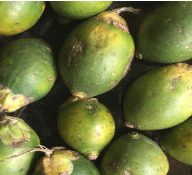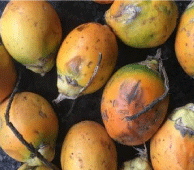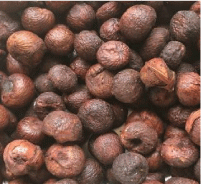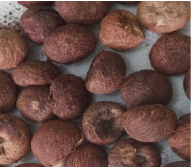
Special Article - Proteins
Austin J Nutri Food Sci. 2019; 7(1): 1113.
Estimation of the Major Constituents of Arecanut in Its Different Forms
Shwetha HR1*, Kotrashetti VS1, Reddy N2 and Chaitanya Babu N3
¹Department of Oral Pathology, Maratha Mandal’s N G Halgekar Institute of Dental Sciences & Research Centre, India
²Centre for Incubation, Innovation, Research and Consultancy, Jyothy Institute of Technology Campus, India
³Chaitanya Dental Clinic, Basaveshwanagar, India
*Corresponding author: Shwetha HR, Department of Oral Pathology, Maratha Mandal’s N G Halgekar Institute of Dental Sciences & Research Centre, Postal Address: #156/10, 24th cross, Kempamma Devi Layout Hulimavu, Bannerghatta Road, Bangalore-560076, Karnataka, India
Received: March 14, 2019; Accepted: April 26, 2019; Published: May 03, 2019
Abstract
Background: Arecanut (AN) is a seed of the plant named Areca catechu L and considered as a significant agricultural crop in many parts of the world. The composition of arecanut varies during its stages of maturity which changes the flavor and astringency.
Objectives: The aim of our study was to analyze the major constituents like alkaloids, carbohydrates, proteins, tannins and mineral matter present in Arecanut during its various stages of maturity.
Materials and Methods: Arecanut was purchased from the local market and extract was obtained by reflux method. Estimation of major constituents were done in its different forms.
Results: Our report showed the chemical composition varied accordingly as the nut attained the stages of maturity. Areca seeds contain considerably high concentration of flavonoids and phenolic, which contribute to strong antioxidant property. Ripe arecanut showed high amount of tannins, proteins and carbohydrate contents whereas the unripe form of AN contained least protein and tannin content. Roasted nut possessed the least carbohydrate content, tannin and protein content was lesser than ripe and higher than unripe form. Dried form contained highest amount of carbohydrates and copper and least concentration of alkaloids, proteins and tannins.
Conclusion: Further studies in depth regarding the analysis are required to infer the role and exact mechanism of these individual constituents on human system might be beneficial to help us in utilization of this nut to treat diseases.
Keywords: Arecanut; Alkaloids; Carbohydrates; Minerals; Proteins; Tannins
Introduction
The tradition of chewing plant and their products as a part of their habit are of great antiquity. Among these plant products, chewing of Arecanut (AN) has been mentioned in ancient literature of Sanskrit, Greek and Chinese manuscripts as early as 1st century BC.
It was used along with food and for medicinal, social and religious purposes [1]. AN is usually consumed alone or as betel quid along with a large variety of ingredients, such as catechu, betel leaf, lime, tobacco, various coloring and flavoring agents, perfumes and stimulants as a part of their culture in many Asian countries including India [2]. It is also the fourth most frequently used psychoactive substance after nicotine, ethanol and caffeine respectively [3]. The ingredients used for the preparation of arecanut might vary according to the culture group and individuals.
The world’s largest producers of AN, is Sri Lanka, Melanesia and West Malaysia which was estimated by Food and Agriculture Organization [4,5]. The AN palm, known as Areca catechu is grown mostly in India, Malaysia, Micronesia, Polynesia and other South Pacific Islands [2]. The plant bearing the fruit are round to ovoid with pointed apex measuring about 3-5cm and 2-4 cm in length and diameter respectively. AN, which is the seed of the endosperm of the fruit where the outer covering (endosperm) of the surface appears green considered to be unripe and yellow to orange when ripe.
The seed or the nut is separated from fibrous pericarp which appears opaque and colored with wavy dark lines. The nut has slightly bitter taste and characteristic astringency and is consumed by the individual during its different stages according to their preference. The different stages of AN involves husking fresh raw fruit, removing the nut, drying nuts in the sun or with artificial heat, baking or roasting, boiling and fermentation.
These treatments change the flavor of AN and its astringent properties [6]. Around 90% of AN harvest are available for commercial preparations of products which are manufacture of large scale [7]. One such type is called ‘red supari’ obtained from boiling and drying the unripe dehusked AN (mature or tender nut). Another type is known as ‘white supari’, which is obtained from ripe nut being sun dried and later DE husking it [8].
The important composition of AN are carbohydrates (20%), fats (15%), proteins, crude fiber, polyphenols (20%), alkaloids (05%) and mineral matter [9].
a) Polyphenolic compounds: The polyphenol are mostly flavonoids and tannins, include about 10% of (+) catechin, 2.5% epicatechin, 12% of (+) leucocyanidin, the remaining contents being flavonoids of varying degrees of polymerization [10].
b) Alkaloid: Major alkaloids isolated from AN are four which includes arecoline (7.5 mg/g), arecaidine (1.5 mg/g), guvacine (2.9 mg/g) and guvacoline (7.5 mg/g) [11].
c) Fat: It constitutes 15-17% of dry weight of the nut. Fatty acids present in AN are 46.2% of myristic acid, 19.5% of lauric acid, 12.7% of palmitic acid, 7.2% of hexadecenoic acid, 6.2% oleic acid, 1.6% of stearic acid, 5.4% of dodecenoic acid, 0.6% of tetradecenoic acid [12].
d) Mineral content: The mineral content includes copper, calcium (0.05%), iron (1.5mg/100g), phosphorus (0.13%) and many more. Apart from these, the nut also contain Vitamins like B6 and C [13].
The difference in each concentrations of the various constituents in nuts are noticed due to different geographical locations and stages of the degree of maturity of the nut [14]. Although available studies have already demonstrated that areca fruit contains many compounds, but we did not come across many studies which highlighted the composition of different forms of AN. The main intention of this study was to estimate and compare the chemical constituents of AN available in different forms.
Materials and Methods
Collection and extraction of AN
Arecanut available in its different forms like unripe, ripe and roasted forms (Figures 1-3) were purchased from a local market at Shivamoga, Karnataka, India, since it is known to be the highest producers of AN in Karnataka. A part of ripen form of AN was kept for sun drying (Figure 4) for 4 months and later sent for analysis.

Figure 1: Unripe form of Arecanut.

Figure 2: Ripe form of Arecanut.

Figure 3: Roasted form of Arecanut.

Figure 4: Dried from of Arecanut.
Extraction procedure of arecanut by reflux method
AN extraction of all four forms were carried out at DR Bioscience’s laboratory, Bangalore by reflux method. The course powder of the nuts were prepared, out of which 1kg of roasted, 500gms of unripe, 300gms of ripe and 300gms of dried were used for extraction process in four different one liter round bottom flask. For all four forms reflux of the same compounds at 60oC were done for 4hrs using methanol as a solvent. After 4hrs the solvent was removed and the same protocol was followed until a clear solution was obtained. Later entire solution from the flask was collected separately and these solutions were concentrated by reducing the pressure in a glass bottle and sent for analysis. Major constituents of AN like carbohydrates, proteins, tannins and alkaloids was carried out. Copper analysis was done using scanning electronic microscope.
Estimation of total carbohydrates by anthrone method
Standard working solution of 10 to 100μl (10μg-100μg) was taken in six different test tubes. Volume was brought up to 100μl in each test tube by adding water; later 400μl of anthrone reagent was added and mixed well. The test tubes later were incubated in the water bath for 8mins, and then cooled at room temperature and measured the optical density by photoelectric calorimeter at 630nm or red filter can be used. A blank solution with 4ml of anthrone reagent and1ml was prepared. Calibration curve was constructed on a graph paper by plotting absorbance at 630nm on the y-axis and glucose concentration of 10μg-100μg on X-axis. Sugar concentrations in the sample from the calibration curve was computed [15].
Estimation of total protein by Bio-Rad DC assay
Preparation of working reagent (as per company protocol): 20μl of reagent S added to each ml of reagent that will be needed for the run. Bovine serum albumin was weighed accurately 100mg and transferred it into a clean 100ml volumetric flask, dissolved with distilled water and made up the volume till 100ml. From this 10, 20, 40, 60, 80, 100μl was pipetted into clean microliter plate whose corresponding concentration ranged from 10μg -100μg. 25μl of sample was transferred into the microtiter plate (sample preparation same as in tannin estimation) and 25μl of reagent A was added into each well followed by 200μl of reagent B and incubated the plate for 15mins at room temperature. The absorbance was read at 750nm against blank [16].
Estimation of total tannin content by spectrophotometric method
Preparation of Standard solution of gallic acid: Stock solution was prepared by taking100mg of Gallic acid, which was transferred to volumetric flask of 100ml, and the concentration was made up to 100mg/100ml with water. From this stock solution, working solution was made by transferring 10ml to 100ml of stock solution and final volume made up with distilled water to 100μg/100ml. From this the different concentration i.e., 1-10μg/ml was prepared [17].
Preparation of Standard curve: Transferred different volumes ranging from 10μl-100μl corresponding to the concentration 1-10C/ ml into clean microtiter plate of 96 wells and volume was made until 100μl with distilled water. To this 50μl of Folin-phenol reagent was added followed by 70μl of 700mM sodium carbonate solution to each wells. The reagents in tube were mixed and kept undisturbed for about 30mins at 37 oC. The absorbance at 760nm against blank was read.
Estimation of alkaloids by bromocresol green method
Sample preparation: 100mg AN extract was dissolved in 2ml of 2N HCl and then filtered. 1ml of the solution was later transferred to separator funnel, washed in 10ml chloroform thrice. Neutral pH was maintained by adding 0.1N NaOH to the solution. Then 5ml of phosphate buffer and 5ml of bromocresol green (BCG) solution were added. The mixture was mixed and the complex which was formed was extracted with 1,2,3 and 4ml of chloroform. The extracts got were collected in 10ml of volumetric flask and diluted with chloroform. The absorbance was measured at 470nm [18].
Estimation of total arecoline content using HPLC
It was done by subjecting the prepared sample to the HPLC method, the Arecanut extracts in its different forms were weighed accurately and dissolved and diluted with methanol to obtain the required concentration. All the solutions of extracts and standards were filtered through a 0.45μm Millipore syringe membrane filter and analyzed using HPLC (High Performance Liquid Chromatography). The extraction protocol and the preparation of sample for the quantification of arecoline were carried out for each sample prepared in triplicates [18].
Estimation of total copper content
Sample preparation: Samples of fine-grained Arecanut fragments were mounted on Scanning Electron Microscope (SEM) mount for eventual electron microscopy. Surface analysis was done using SEM which was equipped with X-ray spectroscopy for energy dispersion and operated at a voltage of 15kV, current 8–10nA, beam diameter of 6nm, vacuum chamber pressure of 50Pa. The spectral lines were identified by spectral decomposition along with holographic deconvolution using deconvolution targeted peak function [19].
Results
Our results showed variations in the composition of arecanut in its different forms (Table 1). Total carbohydrate content was highest in dried form followed by riped and unriped whereas least in roasted form. Total protein content were highest in riped form and least in dried form. The tannin concentration were highest in riped form followed by roasted and unriped whereas least in dried form. The total alkaloids composition was highest in riped form and least in dried form. Copper content was maximum in dried form and less in unriped form.
Arecanut form
Total Carbohydrate Concentration in %
Total Arecoline Concentration in %
Total Alkaloids Concentration in %
Total Protein Concentration in %
Total Tannin Concentration in %
Total Copper Concentration by weight
Unriped
1.287879
0.052241035
0.062048193
0.039808
2.929166667
2.07
Riped
1.668182
0.075532497
0.139759036
0.079615
6.572916667
3.31
Dried
1.856818
0.037091668
0.061445783
0.031058
0.280492091
3.63
Roasted
0.759091
0.044850856
0.064457831
0.045385
3.56875
3.30
Table 1: Shows the chemical composition of arecanut in its different forms.
Discussion
Arecanut is one of the important and a major cash crop agricultural product in many parts of the world and its production is localized to few states in India. It is one of the significant crop grown in Western and Eastern Ghats, North and East parts of India including Karnataka, Kerala, Assam, Meghalaya, Tamil Nadu and West Bengal. Karnataka leads the production of arecanut in our county accounting for 43% area wise and 46% production wise followed by Kerala showing 24% and 23% respectively. The areas of Shimoga Chikkamagaluru, Tumkur, Uttara and Dakshina Karnataka are the places where AN production is seen. Shimoga ranks first in the area (23%) and production (21%) of AN in Karnataka followed by Chikkamagaluru. The two major varieties of processed form of AN, Chali or the sun dried type and Red or boiled type available. Chaliis mainly produced in Dakshina Karnataka and parts of Uttara Karnataka.
Literature shows studies and reviews done to analyse the contents of raw and processed forms of AN, but we did not come across any studies done to analyse the composition during the different stages of AN. Hence we analysed the important constituents of AN during its various forms. The relative amounts of these constituents are variable in different regions as well as in dry or raw/wet forms of AN. Climatic conditions and geographic growth of this tree along with stages of maturity of nut and methods of curing are also one of the reasons that show differences in the constituent compositions [20,21].
Alkaloids being one of the important constituent of AN are reduced pyridines. These contains several alkaloids, of which 4 alkaloids are important namely arecoline, arecaidine, guvacine and guvacoline which are related chemically. Amongst these arecoline (1,2,4,5-tetrahydro-1-methyl-pyridinecarboxylic acid) is the major alkaloid and is known to have many effects on human system followed by arecaidine. Other alkaloids like arecolinidine, guvacine and guvacoline are also seen in small traces [20]. Arecoline and guvacoline are converted into arecaidine and guvacine under alkaline conditions, respectively [22]. Jayalakshmi & Mathew (1982) studied the composition in ripe and unripe nut where the ripe nut showed high arecoline content [23]. Huang & McLeish (1989) studied the alkaloid content in the nuts from Darwin, Australia where arecoline and arecaidine concentration was more than the other two [24]. Our results were similar in comparison with Huang study where the ripen form possessed the highest alkaloid content(0.13%). Alkaloids including arecoline content was reduced following processing of the nut in our study. However, the composition of these alkaloids vary following processing of the nut by different methods in different regions. Boiling of AN in the liquor obtained from previous year boiling liquid increase the alkaloid content of treated nuts [9]. Freezing or cold storage of AN does not change the amount of these alkaloids. These alkaloids may be converted to derivatives, which produce diazohydroxide derivatives, which has been demonstrated in the saliva of betel quid chewers [25].
Flavonoids and tannins are the prominent polyphenols found in AN. During mastication of AN or betel quid, these polyphenols are oxidized due to which the teeth, saliva and lips confers red colour [26]. Amongst the polyphenols, tannins comprise of large portion in the dry nut, which can precipitate proteins. This precipitation is responsible for the astringent taste of the nut. Its content in AN varies based on the degree of the nut maturity and the methods chosen for processing according to Raghavan and Baruah [13]. A study conducted by Awang showed roasted nut contained high tannin content (21.4%) and least in boiled nuts (17%). Our results were in contrast with Awang results where tannin content was highest in ripe form (6.57%) and least in dry nut (0.28%) [27].
In the present study total protein and carbohydrate percentage was analysed. Carbohydrate content was seen highest in dried nut (1.85%) and least in roasted form (0.75%). Proteins were maximum in ripe form(0.079%) of AN and least in dried form (0.031%) of AN. Jayalakshmi et al. conducted a study to analyse the chemical constituents of unripe and ripe form of AN where the carbohydrate content was high in ripe form compared to unripe form and protein content was more in unripe form than ripe form. These results were in contrast with our study [23].
AN has also known to contain Sodium, magnesium chlorine, calcium, manganese, copper, vanadium and bromine [28]. In our study, we analyzed copper content in samples of different forms of AN and reports have shown copper concentration in AN to be much higher than other nuts consumed by humans [14]. The average concentration of the copper in the processed samples of commercially available AN was 18 ± 8.7μg/g [29] Gopalan et al. reported that the content of copper in processed AN from was 2.5 times more that of raw nut [30]. Commercially available form of AN showed high copper content in studies conducted by Mathew et al and Shakya et al. [9,31] Our reports showed dried form of AN with high copper content and least in unripe form which meant the percentage increased as the maturity of AN changed.
An overview of the analysis report obtained from our study showed presence of tannins to be maximum (6.5%) followed by copper (3.6%) and least being proteins (0.03%). AN analysis in different forms found that the overall percentage of carbohydrates, proteins, tannins and alkaloids including arecoline were highest in ripe form of AN. The unripe form of AN contained least protein and tannin content. The carbohydrate content was in between ripe and roasted forms. Roasted nut possessed the least carbohydrate content, whereas tannin and protein content was lesser than ripe and higher than unripe form. Dried form contained highest amount of carbohydrates and copper, while it showed least concentration of alkaloids, proteins and tannins.
Conclusion
In conclusion, our reports showed the percentage of the major phytochemical constituents and copper content of Arecanut varied during its different maturity stages. Ripe areca nut contained high amounts of tannins, proteins and carbohydrates. Consuming of ripe nuts seems to have deleterious effects on oral tissues as the alkaloid content, which is known as the causative substance for sub mucous fibrosis was more in ripe form. The alkaloids, flavonoids and trace elements from areca nut are known to have both beneficial and ill effects on our system. This depends on the percentage of these constituents present in the nut also the amount consumed. With this scenario, it is only prudent to consider that the causative substance or element is maximum in ripe form, but still cannot be concluded. Further studies are required to know the role and exact mechanism of these individual constituents on human body which might help us in utilization of this nut to treat diseases.
Acknowledgement
The authors gratefully acknowledge the assistance rendered by the staff of DR Biosciences Laboratory, Jayanagar 4th Block, and Bangalore.
References
- Ahuja SC, Ahuja U. Betel Leaf and Betel Nut in India: History and uses. Asian Agri-History. 2011; 15: 13–35.
- Betel-quid and areca nut chewing: review. IARC monographs on the evaluation of the carcinogenic risk of chemicals to humans. 1985; 37: 137- 202.
- Bhat SJ, Blank MD, Balster RL, Nichter M. Areca nut dependence among chewers in a South Indian community who do not also use tobacco. Addiction. 2010; 105: 1303-1310.
- Lyon. Betel-Quid and Areca-nut Chewing and Some Related Nitrosamines. IARC Monographs on the Evaluation of the Carcinogenic Risk of Chemicals to Humans Tobacco Habits Other than Smoking. IARC Press. 1985a; 37.
- Lyon. Betel-quid and Areca-nut Chewing and Some Areca-nut-derived Nitrosamines. IARC Monographs on the Evaluation of the Carcinogenic Risk of Chemicals to Humans. IARC Press. 2004; 84: 44-49.
- Staples GW, Bevacqua RF. Areca catechu (betel nut palm). In Species Profiles for Pacific Island Agroforestry; Elevitch, C.R., Ed.; Permanent Agriculture Resources (PAR): Holualoa, HI, USA. 2006; 1-17.
- Chen LQ. The Cultivation and development status of Chinese areca nut industry. Mod Agric Sci Technol. 2007; 5: 114–117.
- Selvan MT, Sivaraman K, Manoj Kumar K. Economics, marketing and development. In: Arecanut. Eds: Balasimha D, Rajagopal V. Central Plantation Crops Research Institute, Kasaragod, Kerala, India. 2004; 259- 301.
- Mathew P, Austin RD, Varghese SS, Manojkumar AD. Role of Areca Nut and its Commercial Products in Oral Submucous Fibrosis- A Review. J Adv Med Dent Scie Res. 2014; 2: 192-200.
- Mathew AG, Govindarajan VS. Polyphenolic substances of arecanut II. Changes during maturation and ripening. Phytochemistry. 1963; 3: 657-665.
- Nai-Shin C. Effects of Betel Chewing on the Central and Autonomic Nervous Systems. 2001; 8: 229-236.
- Pathak SP, Mathur SS. The component acids and glycerides of areca nut (Areca catechu) fat. Journal of the Science of Food and Agriculture. 1954; 5: 461-465.
- Raghavan V, Baruch HK. Areca nut: Indian’s Popular Masticatory. History, Chemistry and Utilization. Journal of Economic Botany. 1958; 12: 315-345.
- Trivedy C, Baldwin D, Warnakulasuriya S, Johnson N, Peters T. Copper content in Areca catechu (betel nut) products and oral submucous fibrosis. Lancet. 1997; 349: 1447.
- Hedge JE, Hofreiter BT. Carbohydrate Chemistry. In: Whistler RL and Be Miller JN, Eds. Academic Press, New York. 1962; 17.
- Peterson GL. Review of the Folin Phenol Protein Quantitation Method of Lowry, Rosebrough, Farr, and Randall. Analytical Biochemistry. 1979; 100: 201-220.
- Polshettiwar SA, Ganjiwale RO. Spectrophotometric estimation of total tannins in same ayurvedic eye drops. Ind J Pharm Sci. 2007; 69: 574-576.
- Shamsa F, Reza MH, Rouhollah G, Reaz VRM. Spectroscopic determination of total alkaloids Peganumharmala L. using bromocresol green. Research journal of phytochemistry. 2007; 1: 79-82.
- Rokosz K, Hryniewicz T, Matysek D, Raaen S, Valicek J, Dudek L, et al. SEM, EDS and XPS Analysis of the Coatings Obtained on Titanium after Plasma Electrolytic Oxidation in Electrolytes Containing Copper Nitrate. Materials. 2016; 9: 318-330.
- Sharan LN. Association of betel nut with carcinogenesis- A review. Cancer J. 1996; 9: 13-19.
- Chin-Kun W, Wen-Hsiu L, Chin-Hui P. Contents of Phenolics and Alkaloids in Areca catechu Linn. During Maturation. J Agric Food Chem. 1997; 45: 1185- 1188.
- Wang CK, Hwang LS. Study on the separation and hydrolysis of alkaloids from betel nut. Food Sci. 1993b; 20: 514-526.
- Jayalakshmi A, Mathew AG. Chemical composition and processing. In: Bavappa, KVA, Nair MK & Kumar TP, eds, The Arecanut Palm, Kerala, Central Plantation Crops Research Institute. 1982; 225–244.
- Huang JL, McLeish MJ. High-performance liquid chromatographic determination of the alkaloids in betel nut. J Chromatogr. 1989; 475: 447-450.
- Nair J, Ohshima H, Friesen M, Croisy A, Bhide SV. Tobacco specific and betel nut-specific N-nitroso compounds: occurrence in saliva and urine of betel quid chewers and formation in vitro by nitrosation of betel quid. Carcinogen. 1985; 6: 295-303.
- Sharan RN, Mehrotra R, Choudhury Y, Asotra K. Association of Betel Nut with Carcinogenesis: Revisit with a Clinical Perspective. PLoS ONE. 2012; 7: e42759.
- Awang MN. Quantitative analysis of areca catechu (betel) nut flavanols (tannins) in relation to oral submucous fibrosis. Dent. J Malaysia. 1987; 9: 29-32.
- Ridge C, Akanle O, Spyrou NM. Elemental composition of betel nut and associated chewing materials. J Radioanal Nucl Chem. 2001; 249: 67-70.
- Trivedy C, Warnakulasuriya S, Peters TJ. Areca nuts can have deleterious effects. Br med J. 1999; 318: 1287.
- Gopalan C, Rama Sastri BV, Balasubramanian SC. Nutritive Value of Indian Foods, National Institute of Nutrition, Indian Council of Medical Research, Hyderabad, India, revised edition. 1989.
- Shakya S, Ongole R, Sumanth KN. Copper content of various constituents of betel quid. Indian J Dent Res. 2009; 20: 516.